2-Quart Collapsible Water Canteen

The collapsible water canteen is intended for use in temperate and tropical environments for carrying drinking water.
Plastic Water Canteen (M-1961)
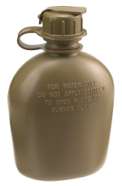
The canteen is intended primarily for use in temperate and tropical environments for carrying drinking water.
M1 Water Canteen Cap
The M1 canteen cap contains a hole that allows an external drinking tube of a chemical protective mask to be connected to the 1-quart or 2-quart canteen.
Cold Weather Hydration Set

The Cold Weather Hydration Set (CWHS) consists of two wide mouth 32 oz. bottles with lids, two water bottle parkas with strap, and one cup. CWHS provides Marines a lightweight capability to carry and protect water from potentially harmfully contaminates, while also extending the temperature of the liquid. Additionally, the cup will provide a means to prepare food, drink and/or boil water.
Water Canteen Cup with Wire Handle

The water canteen cup are for use with the plastic water canteen. The cup is used for drinking hot and cold liquids, soups, and stews in the field.
Canteen Cup Stand

The stand is intended for use with the cup of the water canteen, and compressed ration heating fuel to heat water and individual components of the Meal, Ready-to-eat. The stand is designed to be carried in the water canteen cover, with the canteen cup nested inside the stand, and the canteen nested in the cup.
All-purpose Lightweight Individual Carrying Equipment

The All-purpose Lightweight Individual Carrying Equipment (ALICE) was adopted as Standard A on 17 January 1973 to replace M-1956 and M-1967 systems.
Body Armor/Load Carriage System

The SPEAR Body Armor/Load Carriage System (BALCS) consists of body armor, an equipment load carrying subsystem, and a backpack subsystem.
Waterproof Clothing Bag
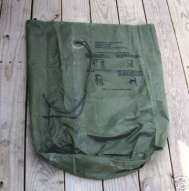
The waterproof clothing bag is intended to be a carrying bag providing waterproof protection for rations, extra clothing, personal effects, and the intermediate cold and extreme cold sleeping bags. It is not constructed to withstand rough use or handling. Should the area of operation or assigned function involve rough handling and waterproofing is required, the waterproof bag should be placed inside a bag of more rugged construction such as the duffel bag to prevent the waterproof bag from damage that would result in leakage.
Marine Corps Close Quarters Battle Equipment
The Marine Corps Close Quarters Battle Equipment (CQBE) consists of the assault suit, assault vest system, individual assault kit, assault gas mask, assault breacher kit, and assault breacher torch kit.
2-Quart Collapsible Water Canteen Cover

The cover is designed to serve as a protective carrier for the 2-quart collapsible water canteen. The cover can be carried with the shoulder strap or attached to the individual equipment belt.
Family of Improved Load Bearing Equipment

Family of Improved Load Bearing Equipment (FILBE) utilized by the United States Marine Corps is designed to allow Marines to carry equipment needed in support of combat operations. The load bearing erquipment system is modular in order to meet the unique needs of the warfighter. The system will maximize the ability to carry combat loads efficiently, minimize the burdens of weight, improve overall system compatibility and increase the combat effectiveness of the user.
Full Spectrum Battle Equipment

Full Spectrum Battle Equipment (FSBE) reduces the component weight, provides a single point of release mechanism, and has an integrated breathing and flotation system. FSBE replaces the Close Quarters Battle Equipment (CQBE) Assault Vest System (AVS).
Integrated Individual Fighting System
In 1988, the Integrated Individual Fighting System (IIFS) was adopted by the Army. The design was based on commercial backpacks modified for military use with the addition of a special fighting vest and a detachable patrol pack. The original focus was to develop a load-carrying system for use in cold weather. However, in the final analysis, the Army selected the new internal frame system as a replacement for the external framed All-purpose Lightweight Individual Carrying Equipment system.
Improved Load Bearing Equipment
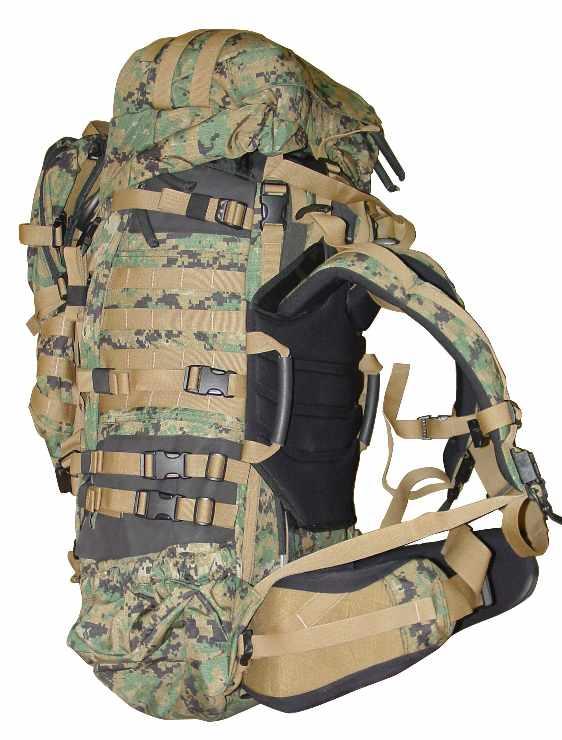
The Improved Load Bearing Equipment (ILBE) is a load carrying system designed to provide a durable and lightweight means for the deployed Marine to transport individual combat clothing and equipment, and replace MOLLE.
Individual Load Carrying Equipment (M1956)

The individual load carrying equipment (ILCE) is intended for use in hot, temperate, and cold-wet regions of the world. It is not for use in cold-dry arctic regions.
Lightweight Individual Clothing and Equipment
Based principally on the conclusions and recommendations of 'A Study to Reduce the Load of the Infantry Combat Soldier', 1962, and 'A Study to Conserve the Energy of the Combat Infantryman', 1964, a Quantitative Materiel Requirement (QMR), was established in 1965 calling for the development of Lightweight Individual Clothing and Equipment (LINCLOE).
Lightweight Load Carrying Equipment (M1967)

Components of the Lightweight Load-Carrying Equipment are similar in design to components of the standard M1956 individual load-carrying equipment.Because nylon materials and aluminium hardware are lightweight, they are used where possible in lieu of cotton materials and brass or steel hardware.The nylon materials are water resistant, retain less moisture and dry faster.
Field Pack Liner

The field pack liner is intended to be used as a liner for field pack to hold items other than subsistence items that must be protected from moisture. The liner is also intended as a flotation device for the individual carrying the field pack.
Modular Lightweight Load-carrying Equipment

The Modular Lightweight Load-carrying Equipment (MOLLE) was designed to replace the All-purpose Lightweight Individual Carrying Equipment (ALICE) and Integrated Individual Fighting System (IIFS) including the Enhanced Tactical Load-Bearing Vest.
Modular Lightweight Load-carrying Equipment II

Based on user feedback on the original system, the MOLLE requirements were modified to eliminate the need for a quick-release frame that integrates into the load bearing vest (LBV).The change allowed developers to replace the probe and socket mechanism, which caused problems in donning for some soldiers and Marines, to a quick-release mechanism for a more traditional permanently-mounted waist belt on the frame.
Pouch Attachment Ladder System

The Pouch Attachment Ladder System is a grid of webbing that consists of rows of heavy-duty nylon stitched onto load-carrying platforms such as backpacks and vests. This system attaches items through the 'inter-weaving' of webbing between the item to be attached and the platform to which it is being attached.
ARVN Rucksack

In 1963 Natick Laboratories developed a tropical rucksack for the Army of the Republic of Vietnam (ARVN).
Lightweight Rucksack

The lightweight rucksack with aluminum frame was developed by Natick Laboratories for cold weather and mountain use as an initial effort to develop lightweight load-carrylng equipment in 1961. It weighed 3 pounds (1.4 kg) as compared to the 7.5 pound (3.4 kg) cotton rucksack with steel frame which it replaced.
Tropical Rucksack

The tropical rucksack is a nylon version of a cotton rucksack for ARVN forces. It has a longer back and more capacity.
General Purpose Sling
The general purpose sling is an adjustable carrying sling made of olive drab 7 colored, 2 inches wide cotton or polypropylene webbing with hardware attached.
Grenade Carrying Vest

The vest has a carrying capacity of twenty-four 40mm grenades used with M79 and M203 launchers.
Individual Equipment Belt

The belt is designed for carrying various items of individual equipment, such as the water canteen and ammunition case which are suspended on the belt by keepers or by double hooks inserted through eyelets so spaced on the belt as to accomodate this equipment. The belt is also used in conjunction with the field pack suspenders, the suspender hooks being attachable to the top edge row of eyelets to help support the weight of the belt and its attached equipment.
Intrenching Tool Carrier

The carrier is designed as a suitable carrier for the intrenching tool covered by MIL-I-43684.
First Aid Dressing/Unmounted Magnetic Compass Case

The case is used to carry two camouflaged individual troop first aid dressing and a package of sodium chloride - sodium bicarbonate mixture, or an unmounted magnetic compass.
Small Arms Ammunition Case (30-Round Magazine)

The case is designed to accomodate three 30-round ammunition magazines for the M-16 rifle. Magazine spacer straps are provided for separating individual magazines, and grenade pockets with retainer straps are provided for carrying grenades. The case is provided with a tab with an eyelet for attachment to the suspender snaphook and two keepers with slide for attaching to the individual equipment belt.
Field Pack Cover

The field pack cover is intended to be used over the medium and large field packs to provide camouflage.
Water Canteen Cover

The canteen cover is designed as a carrier for a one quart nominal capacity water canteen and cup.
Large Combat Field Pack
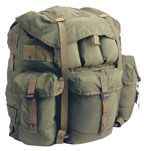
The large field pack is designed to carry up to 70 pounds of existence loads which include clothing, personal items and rations.
Medium Combat Field Pack

The medium field pack is designed to carry up to 50 pounds of existence loads which include clothing, personal items and rations.
Individual Equipment Belt Suspenders

The suspenders are designed for use with the individual equipment belt on which are suspended items of field equipment such as water canteen, ammunition cases, and other items required by the soldier in the field.
Equipment Load Carrying Subsystem
The SPEAR Equipment Load Carrying System (ELCS) is a modular pocketing and harness system allows mission tailoring of load and system configuration.The ELCS is compatible with the SPEAR Body Armor and Backpack Subsystem, and provides optimum compatibility with individual equipment and weapons.
Backpack Subsystem

The modified commercial Backpack Subsystem (UM21) contains a backpack, patrol pack, and butt pack. The backpacks state-of-the-art internal frame affords a stable platform sufficient to carry 120 lbs. effectively. The backpack transfers load efficiently from the shoulders to the waist and provides adjustments to fit the 5th - 95th percentile male SOF operator. The butt pack attaches to ELCS or the backpack; the patrol pack attaches to the backpack, and is compatible with the other SPEAR BALCS components.
Assault Vest System
The assault vest system (AVS) provides the individual Marine with ballistic protection and/or load bearing capabilities necessary for conducting close quarters battle (CQB) missions.
Assault Body Armor

The assault body armor component of the assault vest system (AVS) exceeds the National Institute of Justice (NIJ) Standards for Type IIIA and provides protection from multiple impacts of steel-jacketed 9mm, 123 gr. rounds traveling at 1445 fps and all lesser threats.
Assault Load Bearing Vest

The assault load bearing vest provides a means of carrying mission equipment that allows evenly distributing loads. The modular design allows use of different pouches in varying locations to adapt to different assigned tasks, weapons, equipment and left or right handed individuals. The vest may be worn over the assault body armor (ABA).
USMC Chest Rig

The USMC Chest Rig is a Marine Corps specific modified version of the U.S. Army's Tactical Assault Panel.
Corpsman Assault Pack

The Corpsman Assault Pack (CAP) is an improved design to replace the previously fielded MOLLE Medical Bag.
Corpsman Assault System
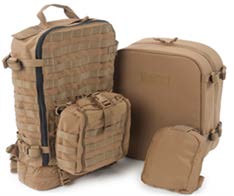
The Corpsman Assault System (CAS) is specifically intended to provide the Corpsman with a load carriage system that fully integrates with the USMC Pack and currently fielded body armor systems.
Marine Corps Grenadier Set

The Grenadier Set is a suite of three 40mm grenade pouches and one 40mm Grenade Multi-Round System (GMRS) to support the standard combat load for a Marine grenadier. The pouches are Commercial-Off-The-Shelf (COTS) and are part of the Family of Individual Load Bearing Equipment.
USMC Pack System

The USMC pack system is specifically intended to provide the Marine with a load carriage system that fully integrates with currently fielded body armor systems.
Marine Corps Equipment Pouches

As a critical element of the Marine's individual load,the ILBE pouches provides a stable platform for thecarriage of equipment and supplies needed across thespectrum of individual and unit operations. The ILBEpouches are a series of robust, specialized pouchescapable of carrying the basic ammunition loadrequired to support and sustain the individual Marineduring combat operations.
Marine Corps Stuff Sack

After Action Reports from Operations Iraqi Freedom and Enduring Freedom demonstrated a compelling need to provide a waterproof bag to protect personal gear from the elements, rain, sand, snow, and moisture. The Marine Corps Stuff Sack will provide Marines a better method of waterproofing and sorting their personal gear stored inside the ILBE packs.
Waterproofing Bag Insert
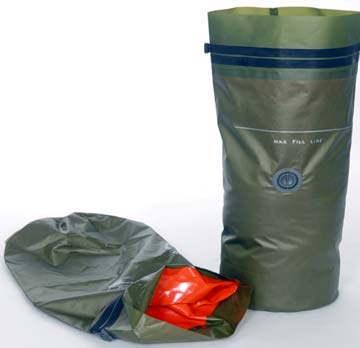
The purpose of the waterproofing bag insert/liner (WPI) is to keep clothing and equipment dry when the ILBE main/assault pack is exposed to prolonged rain or water submersion during field use.
Assault Pack

The Assault Pack of the USMC Pack system has an approximate internal volume of 1525 cubic inches in the main compartment and 300 cubic inches in the front pocket. The Main Pack and Assault Pack components are capable of carrying a maximum combined load of 120 pounds.
Main Pack

The Main Pack of the USMC Pack system has an approximate internal volume of 3400 cubic inches in the main compartment and 1600 cubic inches in the lower compartment. The Main Pack and Assault Pack components are capable of carrying a maximum combined load of 120 pounds.
Sub-belt

The USMC sub-belt integrates with Family of Individual Load Bearing Equipment components without causing interference and allows individual equipment items to be securely attached via Pouch Attachment Ladder System (PALS).
Large Field Pack with Internal Frame and Combat Patrol Pack

The large field pack with internal frame is used to transport the individual's existence load in all environmental conditions. Even load distribution is achieved through the adjustment features. The patrol pack is used for short missions, and can be attached atop the field pack.
Combat Patrol Pack

The combat patrol pack was designed for short missions and offers 1200 cubic inches of cargo space in two compartments.
Grenade Carrier Vest
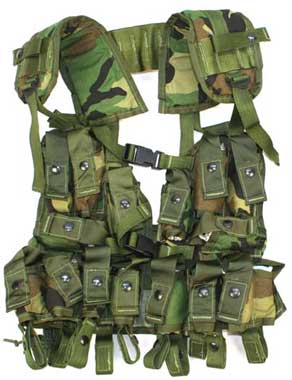
The vest is designed to transport the basic load of 40mm grenade ammunition for the grenadier. It is a one-size-fits-all item constructed of very strong nylon fabric and webbing.
Individual Tactical Load Bearing Vest

The vest is designed to transport the individual's fighting load. It is a one-size-fits-all item constructed of very strong nylon fabric and webbing.
Pistol Belt

The pistol belt helps to support the field pack and is used to carry the intrenching tool and carrier, ammunition pouches, canteen and canteen cover, and first aid or compass case.
Intrenching Tool Carrier

The intrenching tool carrier is made of olive drab cotton duck material and is attached to the pistol belt by means of two attaching clips located on the back. An attachment for carrying the bayonet or bayonet knife scabbard is located on the front of the carrier.
Sleeping Bag Carrier

The sleeping bag carrier is designed so that the sleeping bag and other sleeping equipment can be carried on the back above the field pack. By means of a quick-release system, sleeping equipment can be dropped quickly in case of emergency.
First Aid Packet / Lensatic Compass Case

The first aid case is used to carry either a field dressing or an unmounted magnetic compass.
Small Arms Ammunition Case (M-16A1 20-Round Magazine)
The ammunition case is a shortened version of the universal ammunition case. It is designed to carry four 20-round magazines used with the M-16 rifle.
Canteen Cover

The canteen cover accommodates a one-quart canteen and a cup. The lining on the inside of the canteen cover should be kept wet during hot weather in order to help keep the water in the canteen cool. The cover should be kept dry during cold weather, however, as the lining material provides limited protection in preventing the water in the canteen from freezing.
Combat Field Pack (M1961)

The field pack is used to carry individual rations and equipment that are essential during field operations. It is designed to permit certain items to be carried in a number of different ways to meet changing conditions. For example, the poncho, can be carried inside the pack under the expandable flap or it can be attached to the bottom of the pack by means of the two adjustable securing straps. Extra items of small clothing, such as underwear and socks, also can be rolled and placed under the expandable flap. Outer clothing not in use can be secured under the pack or under the flap, depending on the location of the poncho. In placing items in the field pack, hard objects such as ration cans should be placed on the outside, with softer items such as clothing on the inside toward the wearer's back. A series of eyelets at the edge of the pack flap will accommodate the double hooks used on old field equipment carriers for such items as wire cutters and machetes.
Universal Small Arms Ammunition Pouch

The ammunition pouch is designed to carry any of the basic loads of ammunition. But with special weapons, it may be necessary to carry more ammunition than the pouches will accommodate. When extra ammunition is necessary, bandoleers of ammunition may be carried in a cross-chest manner. To place bandoleers of ammunition in the ammunition pouches, make a neat bundle by folding the bandoleers accordion-fashion and placing them in the pouches with the bandoleer straps at the top. This method permits the bandoleers to be inserted and removed easily.
Pack Adapter Strap

The pack adapter strap permits the field pack to be attached to the suspenders at a position high enough on the individual's back to provide lower space for carrying additional items of equipment, such as canteens and first aid kits, on the pistol belt. The adapter strap also allows the field pack to be carried high enough on the back to permit the carry of heavy loads, such as mortar base plates, ammunition, or radios.
Combat Field Pack Suspenders

The suspenders are used to support, the field pack and the pistol belt. The shoulder pads should be centered on the shoulders in order to distribute the weight of the load evenly. The suspenders may be worn without the field pack. When wearing the suspenders without the field pack, the suspender straps should be attached directly to the pistol belt. To keep the weight of the load evenly on both shoulders, attach the rear suspender straps at even spaces from the center of the rear of the pistol belt.
Individual Equipment Belt

The belt is made from Army shade 7 olive drab nylon webbing with black chemical finish brass hook-type buckle fastener. The medium size belt has an adjustable length ranging between 26- to 43-inches and the large size belt ranges between 33- to 55-inches. The individual equipment items are hooked through eyelets along the bottom of the belt or attached by interlocking slide keepers. The eyelets along the top of the belt are for attaching the field pack suspenders.
Intrenching Tool Carrier

The carrier is used for for carrying the lightweight collapsible intrenching tool.
Sleeping Equipment Carrier

The carrier is 14 inches long, 12 inches wide, has straps with buckles closure for securing the sleeping bag.
First Aid Dressing / Unmounted Magnetic Compass Case
The case is similar to the M1956 first aid/compass case but made of nylon.
Small Arms Ammunition Case (M-16 20 Round Magazine)

The small arms ammunition case is similar to the M1956 M-16 20-rd mag case but made of nylon.
Water Canteen Cover

The canteen cover is similar to the M-1956 canteen cover but made of nylon.
Combat Field Pack

The field pack is larger than the M-1961 field pack and made of nylon.
Field Pack Suspenders

The field pack suspenders are modified H-back type suspenders.
Medical Bag

The MOLLE medical bag was designed to carry a mix of medical supplies and equipment that could be customized for specific missions.
Bandoleer

The MOLLE bandoleer holds up to six additional thirty round magazines and can be slung across the shoulders or fits in the claymore pocket of the main pack or the front pack of MOLLE II assault pack.
Sleep System Carrier

The MOLLE sleep system carrier is designed to accommodate the Modular Sleep System.
Configuration
The MOLLE modularity allows for commanders to tailor the loads to meet mission needs without unnecessary extra pockets and packs.
Load Bearing Vest

The MOLLE Load Bearing Vest (LBV) is a modular vest that allows commanders to tailor the loads to meet mission needs without unnecessary extra pouches and gear.The vest is designed to reduce heat build up on the back with minimum area of coverage with the H-Harness design.The wide shoulder straps of the vest help distribute the load without the need for excessive padding that can hinder mobility and sighting a weapon.
Main Pack

The MOLLE main pack has a volume of approximately 3,000 cubic inches.
Patrol Pack

The MOLLE patrol pack has a volume of approximately 1,200 cubic inches including the outside pocket.
Sustainment Pocket

The MOLLE sustainment pocket has a volume of approximately 500 cubic inches.
Radio Pouch

The MOLLE radio pouch is designed to carry a SINCGARS/ASIP radio.
Combat Medic Set
The MOLLE Combat Medic Set consists of a medic bag and eight external medic modular pouches (four each for the vest and the bag). This set is duty-specific and is issued in addition to the rifleman set.
Molded Waist Belt

The MOLLE II molded waistbelt has no longer a female connector into which the MOLLE frame joins but straps (6) and buckles (7) to attach it to the MOLLE II frame. The waistbelt is designed to be permanently attached to the frame and to distribute part of the main pack or large rucksack load to the hips.
Configuration
The MOLLE II modularity allows for commanders to tailor the loads tomeet mission needs without unnecessary extra pockets and gear.
Hydration System

The MOLLE comes with an on-the-move tube hydrationsystem for special missions where hands-free drinking isdesired.
Improved MOLLE Medic Set

The Improved MOLLE Medic Set (IMMS) is a redesign of the MOLLE Combat Medic Set. It accommodates the changes in Tactical Combat Casualty Care (TCCC) doctrine and enable combat medics to carry additional life saving medical supplies.
Assault Pack

The MOLLE II Assault Pack has an approximate internal volume of 1525 cubic inches in the main compartment and 825 cubic inches in the large front pocket that is specifically sized to house a removable six magazine bandoleer or a standard protective mask and allow quick and easy access to it, and is capable of carrying at least a 60-pound load to include the current family of field radios including SINCGARS and ASIP. The radio can be carried in a radio pouch attached to the rear panel of the pack utilizing the 1 inch oval loops.
Patrol Pack

The MOLLE II patrol pack has a volume of approximately 1,500 cubic inches including the outside pocket that is specifically sized to house a standard protective mask and allow quick and easy access to it, and is capable of carrying at least a 40-pound load to include the current family of field radios including SINCGARS and ASIP.
Waist Pack
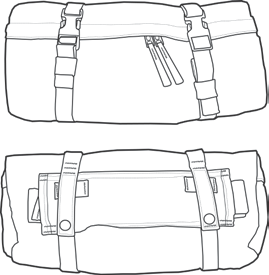
The MOLLE II waist pack has a volume of approximately 350 cubic inches.
Canteen/General Purpose Pouch

The canteen/general purpose pouch has a variety of uses.
Large Rucksack

The MOLLE II Large Rucksack has an approximate internal volume of 2900 cubic inches in the top compartment and 830 cubic inches in the lower compartment, and is capable of carrying a 120-pound load.
Medium Rucksack

The MOLLE II medium rucksack has a volume of approximately 3,000 cubic inches.
Tactical Assault Panel

The Tactical Assault Panel (TAP) replaces the Fighting Load Carrier to allow for quick-release of equipment in emergency situations.TAP is compatible with the quick release system of the IOTV/SPCS.TAP can also be worn like a Ranger Assault Carrying Kit (RACK) using the external webbing harness.
Advanced Combat Helmet Cover

The helmet cover is intended for camouflaging the Advanced Combat Helmet (ACH).
Marine Corps Reversible Helmet Cover
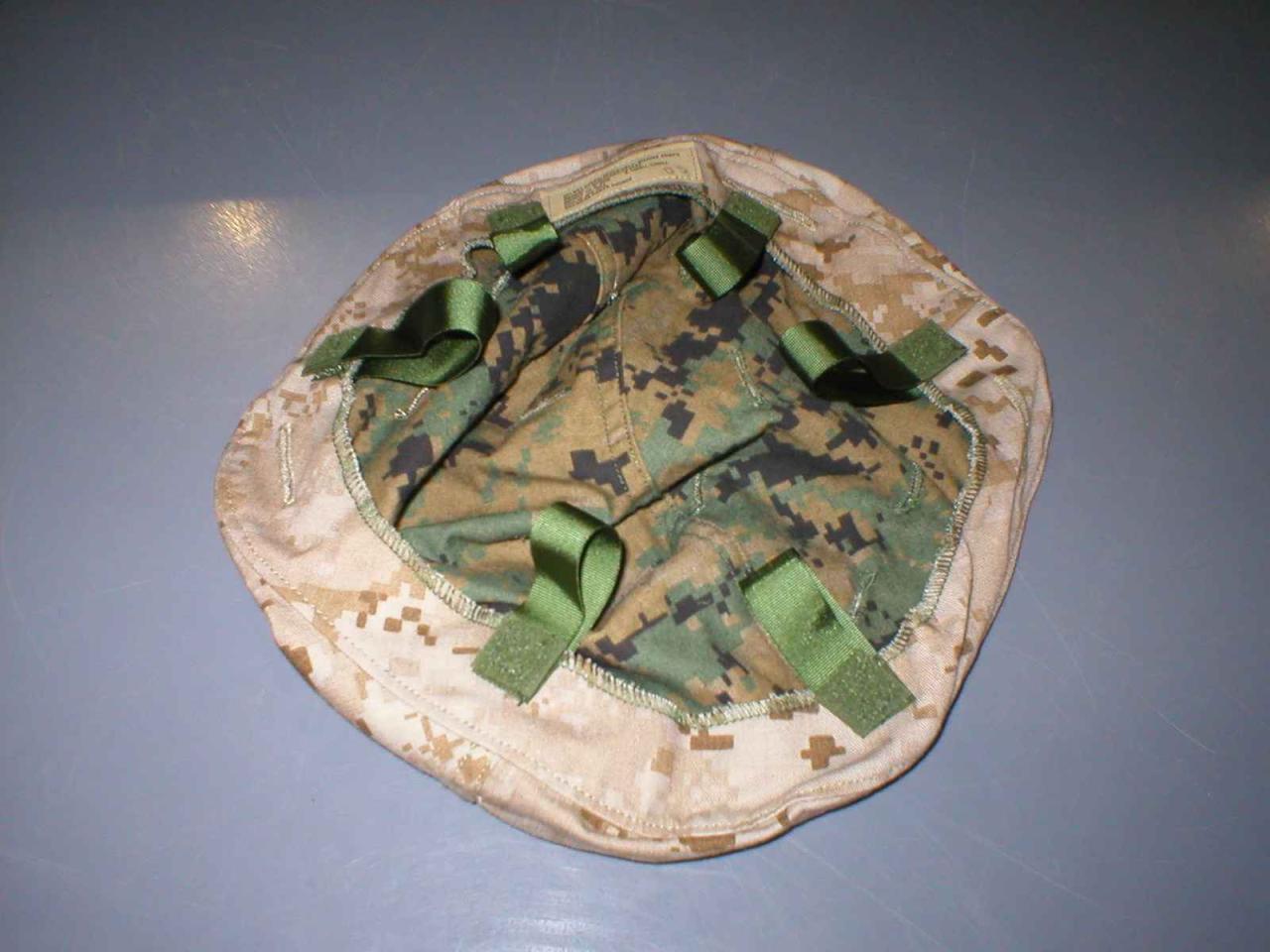
The helmet cover is reversible (MARPAT woodland and desert camouflage pattern) and can be worn in both desert and woodland environments.
Advanced Comabt Helmet Reversible Cover

The reversible cover is intended for camouflaging the Advanced Combat Helmet (ACH) in both the woodland and desert environments.
Advanced Combat Helmet

The Advanced Combat Helmet (ACH) is a modular system that weighs less, fits better, and is more comfortable than its predecessor, the PASGT helmet.
Enhanced Combat Helmet

The Enhanced Combat Helmet (ECH) was developed in response to a 2009 USON to produce a helmet that providesballistic protection from selected small arms ammunition andfragmentation, yet maintains all other characteristics of the Marine Corps' Lightweight Helmet (LWH) and the Army's Advanced Combat Helmet (ACH).
Marine Corps Lightweight Helmet

The Lightweight Helmet (LWH) replaces the PASGT helmet.The LWH provides protection in various operating environments from fragmentation and 9mm small arms projectiles.
Modular/Integrated Communications Helmet

The Modular Integrated Communications Helmet (MICH) began development in 1997 as part of the Special Operations Forces Personal Equipment Advanced Requirements program at the U.S. Special Operations Command. The MICH provides the Special Operations Forces the flexibility to tailor the communications capability of the helmet to the mission using one modular system.
Interceptor Body Armor

The Interceptor Body Armor (IBA) was designed to replace the Personnel Armor System Ground Troops (PASGT) vest and the Interim Small Arms Protective Overvest (ISAPO).
Improved Modular Tactical Vest

The Improved Modular Tactical Vest (IMTV) provides a number of features that improve upon mission performance, user comfort, and improved load carrying capability when compared to the existing Modular Tactical Vest including: modified removable ballistic panel pattern to provide more acceptable body coverage and protection; improved ergonomics, mobility, and fit at the shoulders; improved cummerbund design; improved comfort utilizing a lumbar pad support; and increased PALS footprint for load carriage. The IMTV provides protection from conventional fragmenting munitions and multiple hits from 9mm handgun rounds. The IMTV protection is increased to protect vital organs against multiple hits from small arm rifles and indirect fire flechette when front, back, and side small arms protective inserts are worn.
Modular Tactical Vest

The Modular Tactical Vest (MTV) was developed due to combat operations highlighting the need for operational enhancements to the Outer Tactical Vest (OTV).The OTV, developed in the late 1990's, was not designed to carry heavy loads such as ammo pouches, radios, water carriers and accessories, so many troops either attached cumbersome pockets to the vest or wore an additional load-carrying layer.
Personnel Armor System for Ground Troops

Personnel Armor System for Ground Troops (PASGT) was originally type-classified in the late 1970's and first fielded in early 1980's.
Marine Corps Plate Carrier

The Plate Carrier (PC) improves the load bearing capabilities of the scalable plate carrier, integrates primary components among the improved modular tactical vest, and contours the product for comfort and wear.
Scalable Plate Carrier

The Scalable Plate Carrier (SPC) is used as an additional ballistic vest, not to replace the Modular Tactical Vest (MTV), but to provide additional warfighting effectiveness by allowing greater maneuverability, agility, and mobility with reduced thermal stress in high elevations, thick vegetation, and tropical environments than that provided by the Outer Tactical Vest/MTV. The SPC offers the same level of ballistic protection as the MTV but reduces overall weight by reducing area coverage for fragmentation.
Soldier Plate Carrier System
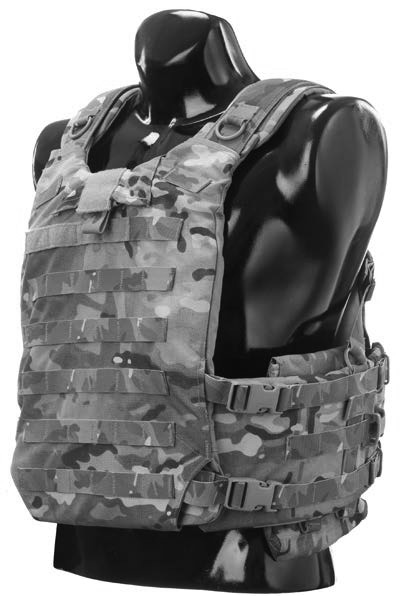
The Soldier Plate Carrier System (SPCS) is designed as a lightweight alternative, not a replacement, for the Improved Outer Tactical Vest, the core of the Interceptor body armor system. It is intended to increase mobility and maneuverability by lightening the Soldier's load when operating on foot in mountainous terrain or at high altitude.
Soldier Protection System
The Soldier Protection System (SPS) provides the Soldier with a modular, scalable integrated system of mission tailorable ballistic protective subsystems at a reduced, from current, weight while maintaining the same level of ballistic protection and mobility provided by the current PPE systems.
Deltoid Axillary Protector

The Deltoid Axillary Protector (DAP) (or Deltoid Axillary Protection System, DAPS) was developed in response to the improvised explosive device (IED) threats that soldiers face in Iraq. Unlike conventional threats, which usually come from the front, back, or above, IEDs throw shrapnel and spall at soldiers from below and from the sides. DAP enables soldiers to cover shoulder and upper arm areas as well as the armpit and underarm. The original Interceptor body armor design is open around the arms to allow air to circulate.
Improved Outer Tactical Vest

The Army began fielding the Improved Outer Tactical Vest (IOTV) in the fourth quarter of 2007. The IOTV is a side-opening vest that provides a greater area of coverage than the Outer Tactical Vest (OTV) and weighs three pounds less.
Outer Tactical Vest

The Outer Tactical Vest (OTV) provides protection from conventional fragmenting munitions and multiple hits from 9mm handgun rounds.
Small Arms Protective Insert

The Small Arms Protective Inserts (SAPI) upgrade the OTV to provide additional protection from rifle-fired threats.
Deltoid Protector

The IOTV deltoid protector has the same basic design as the deltoid protector for the deltoid axillary protection system attached to the outer tactical vest.
Improved Outer Tactical Vest Generation II

The first delivery of the new Gen II Improved Outer Tactical Vest (IOTV) in Operation Enduring Freedom Camouflage Pattern (OCP) began on 16 July 2010.
Improved Outer Tactical Vest Generation III

Incremental enhancements to the Improved Outer Tactical Vest (IOTV) transitioned to production in FY12. Design enhancements included a more robust quick-release technology for improved functionality. Additionally the IOTV Gen III included other design features to improve comfort, mobility and functionality, especially to female and small statured Soldiers.
Groin Protector

The IOTV groin protector has the same basic design as the OTV groin protector.
Lower Back (Kidney) Protector

The IOTV lower back protector provides additional protection for the lower spine and pelvis. The lower back protector attaches to the inside of the back carrier using two nylon straps and snap fasteners.
Yoke and Collar Assembly

The IOTV yoke and collar assembly provides additional ballistic protection to the neck and shoulders.
Deltoid Protector
The IOTV Gen II deltoid protector has the same basic design as the Gen I deltoid protector.
Groin Protector
The IOTV Gen II groin protector has the same basic design as the Gen I groin protector.
Lower Back (Kidney) Protector

The IOTV Gen II lower back protector is a simplified version of the Gen I lower back protector. It has neither PALS webbing nor a utility channel, and the interior fabric is woven nylon similar to the exterior fabric.
Yoke and Collar Assembly
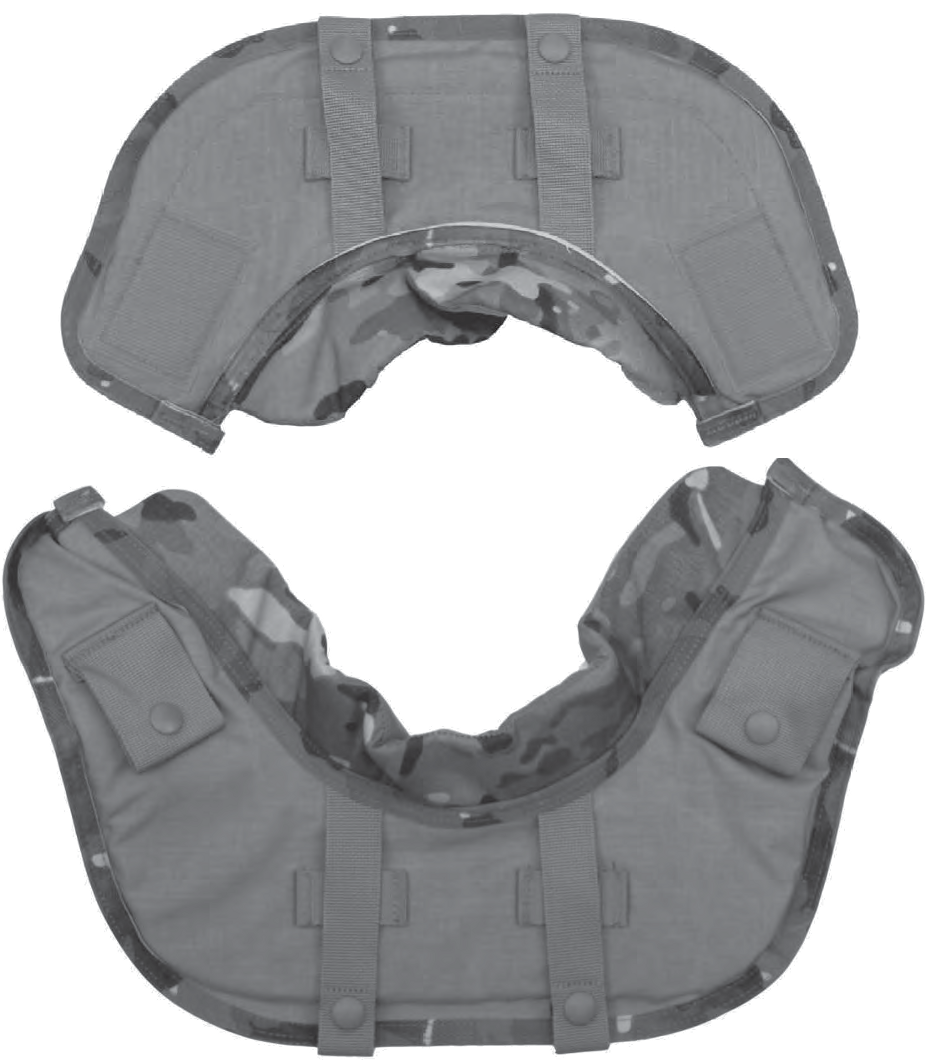
The IOTV Gen II yoke and collar assembly was initially the same as the Gen I yoke and collar assembly except that ballistic inserts are not removable.
Deltoid Protector

The IOTV Gen III deltoid protector has the same basic design as the Gen II deltoid protector.
Groin Protector

The IOTV Gen III groin protector is worn on the ACU trouser, and provides additional protection to the femoral arteries and pelvis. It is a new design for the IOTV Gen III and is attached to the front carrier for storage only. The attachment straps are tucked into the groin protector carrier when not attached to the front carrier.
Lower Back (Kidney) Protector

The IOTV Gen III lower back protector has the same basic design as the Gen II lower back protector.
Yoke and Collar Assembly

The IOTV Gen III yoke/collar assembly has the same basic design as the redesigned Gen II yoke/collar assembly.
Groin Protector

The OTV groin protector provides additional protection for the femoral arteries and pelvis. The groin protector attaches to the inside of the front carrier using two nylon straps and snap fasteners.
Throat Protector

The OTV throat protector provides additional ballistic protection to the throat.
Yoke/Collar Assembly

The OTV yoke/collar assembly provides additional ballistic protection to the back of the neck and shoulders.
Enhanced Small Arms Protective Insert
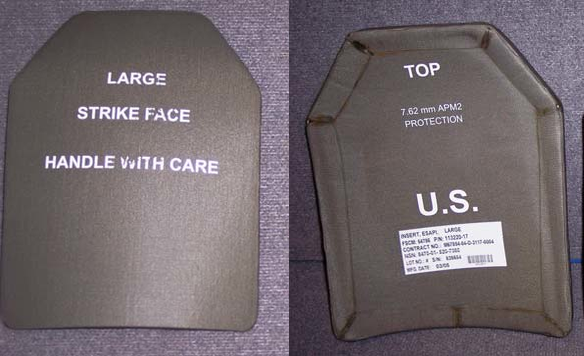
The Enhanced Small Arms Protective Insert (ESAPI) when placed in the Outer Tactical Vest pocket of the multiple threat/Interceptor body armor will provide ballistic protection from specific 5.56 mm and 7.62 mm ball and AP rounds.
Enhanced Side Ballistic Insert and Ballistic Carrier

The Enhanced Side Ballistic Insert (ESBI) plates provide additional coverage as they protect the wearer's sides between the Enhanced Small Arms Protective Insert (ESAPI) plates worn inside the front and rear, and provide the same ballistic protection as the ESAPI.
Enhanced Side Small Arms Protective Inserts and Ballistic Carriers

The Enhanced Side Small Arms Protective Insert (S-SAPI) and ballistic carriers provide increased side torso protection for Marines.
X Small Arms Protective Insert

The X Small Arms Protective Inserts (XSAPI) have tan covers and provide greater protection than the ESAPI for the chest and back.
X Side Ballistic Insert

The X Side Ballistic Inserts (XSBI) have tan covers and provide greater side protection than the ESBI.
Fragmentation Protective Body Armor Vest

The PASGT body armor vest is intended for use by ground troops for protection against low velocity projectiles and grenade fragments.
Ground Troops and Parachutists Helmet

The PASGT helmet is intended for use by ground troops and parachutists to provide ballistic protection from fragmenting munitions to the head, temples, ears, and neck.
Marine Corps Plate Carrier Generation III

The Marine Corps Plate Carrier Generation III (PC Gen III) improves mobility and fit of the legacy PC.
Cummerbund Configuration

An alternate cummerbund configuration adds a cummerbund with soft ballistic and hard plastic inserts and side plate pockets with soft ballistic inserts to the SPCS base vest assembly.
Non-Side Plate Carrier Configuration

The most basic configuration of the SPCS consists of the front and rear carriers with soft ballistic inserts, two shoulder straps, four attachment straps, four quick release buckles, and the quick release cable. The side plate carriers are not worn in this configuration.
Side Plate Carrier Configuration

For increased protection, left and right side plate carriers with soft ballistic inserts can be added to the SPCS base vest assembly.
Sleeping Hood

The sleeping hood is intended to be worn on the head to keep the head area of the sleeping bag clean from head oils, perspiration and dirt.
Marine Corps All Purpose Liner

The all purpose liner (APL) is an improved poncho liner with a zipper closure.
Poncho Liner

The poncho liner is a polyester batting article covered with 3 plys of ripstop nylon, and is intended for use as a sleeping bag when used with a poncho, or as a blanket. The liner has eight tie tapes fot attaching it to the poncho.
Foam Sleeping Mat

The sleeping mat is intended for use as a ground cover in conjuction with the sleeping bag.
Improved Sleeping Mat

The Improved Sleeping Mat (ISM) is designed to be easily folded into a more compact form for carrying and stowage by Marines. The 'accordion-style' fold is durable, while providing improved comfort for quality of sleep without increasing weight.
Self-Inflating Sleeping Mat

The self-inflating sleeping mat is intended to insulate from the cold and moisture of bare ground when placed under a sleeping bag, and also to cushion its user from obtrusive objects when lying on the ground.
Pneumatic Mattress

The pneumatic mattress is inflated by mouth and is intended for use in conjunction with sleeping bags.
Insulated Pneumatic Mattress
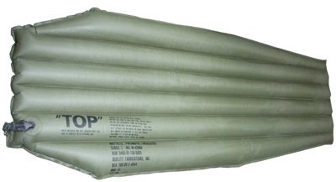
The insulated pneumatic mattress is inflated by mouth and is intended for use in conjunction with arctic and mountain sleeping bags.
Extreme Cold Weather Sleeping Bag

The extreme cold weather sleeping bag is for use in locations where mean monthly temperatures are below +10°F.
Intermediate Cold Weather Sleeping Bag

The intermediate cold weather sleeping bag is for use in locations where mean monthly temperature ranges from +45°F to +10°F.
3 Season Sleep System

The 3 season sleep system (3S) is a single sleeping bag system that is lighter in weight and provides increased environmental protection for all environments except extreme cold weather.
Extreme Cold Weather Sleeping System

The Extreme Cold Weather Sleep System (ECWSS) will provide environmental protection between +40°F and -45°F (+5°C and -46°C) and is intended to be used with the foam sleeping mat.
Intermediate Cold Weather Sleeping System
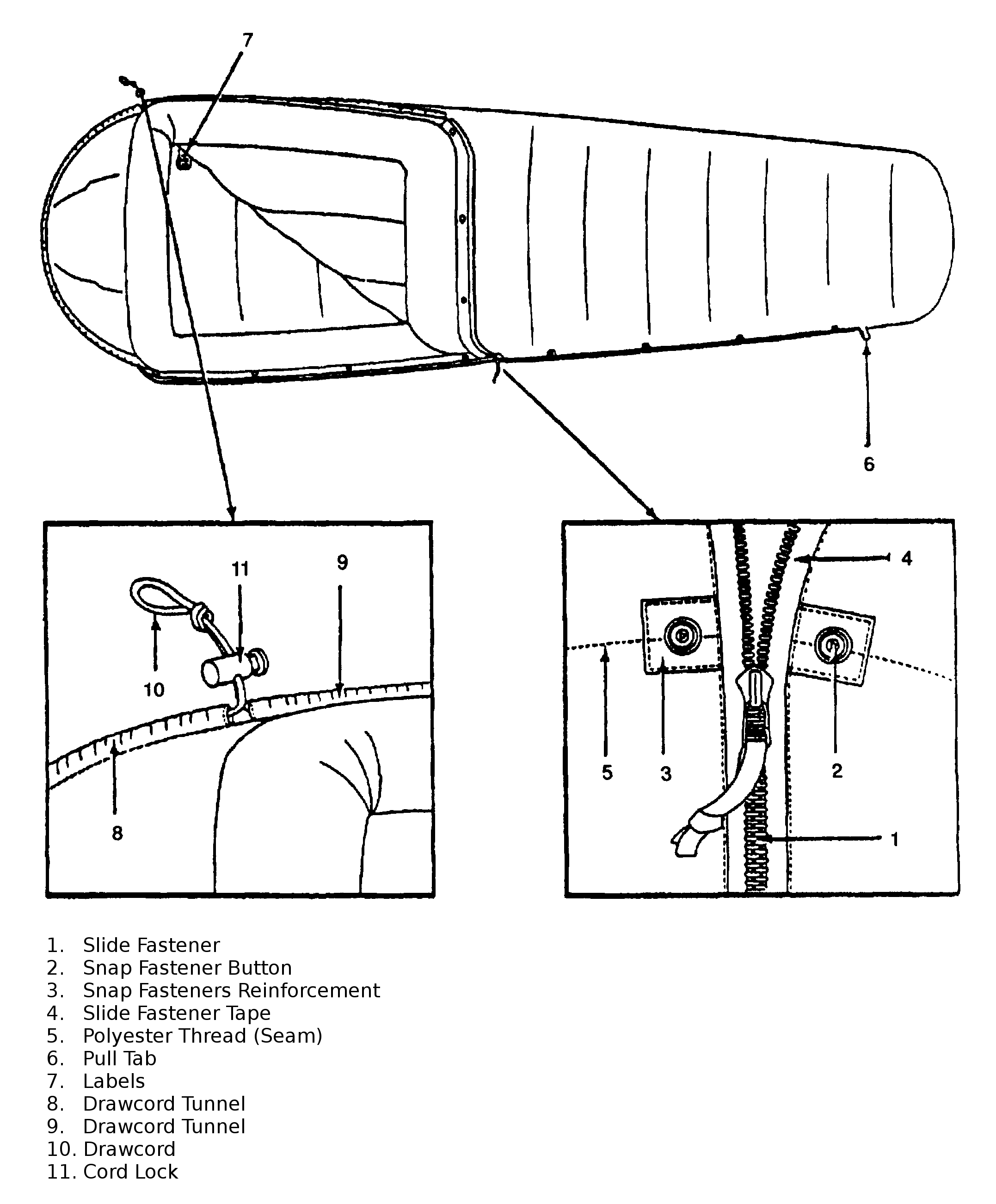
The Intermediate Cold Weather Sleeping System is an ICW version of the extreme cold weather sleeping system.
Modular Sleep System

The Modular Sleep System is designed to insulate the user in environments ranging from mild weather to extreme cold weather.
Arctic Sleeping Bag
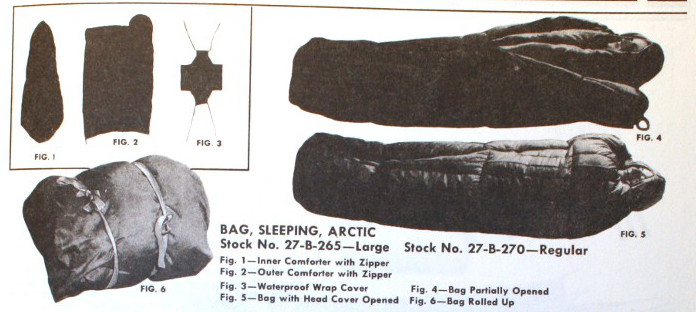
The M-1942 arctic sleeping bag consists of two down and feather filled cases for use in extreme low temperatures. The inner bag is mummy shaped. A full length zipper is used to close the quilt shaped outer bag. A waterproof wrap case, having flaps and tie tapes, is provided for carrying both rolled bags.
Mountain Sleeping Bag

The M-1942 mountain sleeping bag is a mummy shaped, down and feather filled sleeping bag, made in regular and large size, in which an over-lapping tube construction prevents the entry of cold air at the stitching. The shape and design gives maximum warmth with minimum weight. Tie straps are attached to the foot of the bag. A waterproof bag is provided for protecting the rolled bag. The regular bag weighs 5.75 lbs. The large bag weighs 6.00 lbs.
Wool Sleeping Bag

The wool sleeping bag was originally made of knitted wool cloth, which was replaced by a woven, 21 1/2-ounce napped wool cloth because of the extreme shrinkage occurred when laundered. It was mummy-shaped and provided with a 30-inch heavy slide fastener.
Water Repellent Case for Sleeping Bag

The water repellent sleeping bag case is made of poplin and provides a wind-resistant cover for the sleeping bag. It is ordinarily used with all sleeping bags. In warm weather, when little protection is needed, the case may be alone. Two openings in the seam at the foot of the case allow the tie straps on the sleeping bag to to be drawn to the outside to hold the items in a compact unit when rolled. It weighs 1.88 lbs.
Arctic Sleeping Bag
M-1945 arctic sleeping bag consists of two sleeping bags: outer casing and inner casing. Both have full-length opening with zipper and eyelets for lacing the water repellent case.
Mountain Sleeping Bag
M-1945 mountain sleeping bag is identical with inner component of M-1945 arctic sleeping bag.
Water Repellent Case for M-1945 Sleeping Bag

The M-1945 water repellent sleeping bag case provides a wind resistant, water repellent cover for the sleeping bag.
Arctic Sleeping Bag
The M-1949 arctic sleeping bag consists of two mummy-shaped sleeping bags: outer bag and inner bag. It is for use in temperatures of 14°F and below.
Mountain Sleeping Bag

The M-1949 mountain sleeping bag is intended for use in locations where temperature ranges from 14 to 50°F.
Aircrew Integrated Recovery Survival Armor Vest and Equipment
The A/P22P-18(V) Aircrew Integrated Recovery Survival Armor Vest and Equipment (AIRSAVE) provides the aircrew member with integrated survival item stowage, small arms threat protection, flotation device integration, and a Search and Rescue (SAR) lift hoist attachment capability. AIRSAVE replaces Navy/Marine Corps Aircrew Integrated Survival/Armor Protection (AISAP), the Army Aircrew Survival Armor Recovery Vest, Insert, and Packets (SARVIP) and the Air Force SRU-21/P.
Drinking Water Storage Bag
The drinking water storage bags are intended to be included in military personnel survival kits as storage containers for fresh water, for stowing miscellaneous items which must be kept from salt water, or they may be inflated, tied together, and used for flotation purposes, such as survival or swimming.
Aircrew Survival Armor Recovery Vest, Insert, and Packets

The Army's Aircrew Survival Armor Recovery Vest, Insert, and Packets (SARVIP) is a three part system: survival vest, armor insert with carrier, and survival, signal and communication components. SARVIP also accommodates the AN/PRC-90 or AN/PRC-112 radio set and the LPU-10/P life preserver. The SARVIP vest, packets, and other survival, signal and communication components replace the SRU-21/P vest. The SARVIP insert and carrier replace the .30 caliber aircrew body armor.
Individual Survival Kit, Vest Type SRU-21/P

The SRU-21/P survival vest kit is a complete survival package which is worn by personnel on all types of Army aircraft, except OV-1.
Air Force Airsave Vest

The Air Force Airsave vest will serve as the mounting platform for the Joint Service Aircrew Mask (JSAM) tactical components using the Modular Load-carrying Equipment (MOLLE) capability of the vests. Airsave also offers a variety of pockets and attachments suited for specific survival gear and in-cockpit components.
Aircrewmen's Survival Vest

The AIRSAVE survival vest assembly is an adjustable, one-size-fits-all garment, and contains an assortment of modular pockets to accommodate stowage of survival items. The Type I survival vest is used by aircrew members of both helicopter and fixed-wing, non-ejection seat aircraft. Unique features of the Type I vest include a hoisting harness attached to the inside of the vest to accommodate a Search and Rescue (SAR) lift hoist attachment, and a two-way plastic slide fastener to accommodate hard armor operation and doffing.
Aircrew Survival Small Arms Protective Body Armor

The SARVIP body armor is intended to be worn over the chest area to provide protection from small arms fire up to 12.7 mm (.50 cal).
Survival Signal and Communication Components

Placed in the various pockets on the SARVIP vest are the following items: compass, mirror, smoke and Illumination flares, sea dye marker, distress light marker, chemical agent detectors, distress signal kit, operators manual, and survival packets consisting of medical and basic components necessary for survival.
Packets for Aircrew Survival Vest
The packets for the SARVIP vest is of the following four types: basic, medical, first aid dressing and water storage bag, combat casualty bag.
Aircrew Survival Vest

The SARVIP vest consists of a raschel knitted aramid cloth body and aramid oxford cloth pockets. The vest has rescue lift straps and quick release mechanism for emergency recovery operation.